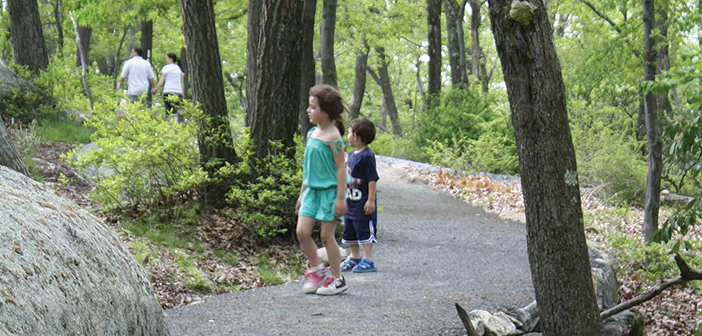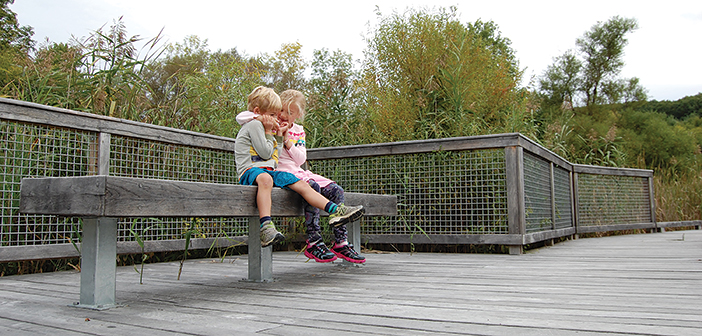The natural landscape is a tremendous asset to many adventure parks. The trees, streams, ponds, wildlife, open space, and views deliver a refreshing perspective beyond our daily routines. Since most guests live in a more urban environment, a trip to the great outdoors is more than just a recreational pursuit. The restorative quality—and health benefits—of being outdoors is universal and well documented, and how the outdoor environment is presented should be a primary consideration in creating a place that delivers more than adrenaline, challenge, and thrill.
John Muir said it best: “Keep close to Nature’s heart… and break clear away, once in awhile, and climb a mountain or spend a week in the woods. Wash your spirit clean.”
Much of this magic occurs while in the treetops crossing bridges, balancing between ropes, and zipping from one point to another. But the design and detail of a park’s facilities contribute to this magic, too. Done right, site design and landscaping can provide guests an authentic experience on the ground and help extend their stay to socialize, relax, enjoy life—and spend more money—in a setting you deliver.
A great outdoor space is fundamental to providing a memorable guest experience, even if it doesn’t directly contribute to the bottom line. Successful outdoor spaces encourage guests to linger, and a memorable day is more likely to trigger the desire to return. Who in our business isn’t focused on increasing length of stay and repeat visitation?

Shade and view at Anakeesta.
The physical environment of the park should reflect your brand and identity from the moment the guest arrives. That takes more than “shrubbing it up” or adding a couple flowerbeds here and there. More and more, guests want authenticity, preservation of the natural environment, and places to enjoy sun, shade, views, and also socialize.
Let’s break down the components that contribute to a successful outdoor experience.
THE ARRIVAL EXPERIENCE
First impressions are key. The guests’ experience begins the moment they see the sign and make the turn. These impressions set the tone for their experience. Think: welcome. Think: life will be better here. Think: WOW! A well-executed sense of arrival establishes the character of a place and a destination.
In most cases, the natural landscape is the palette to work with. Start by using it to craft a gateway to signal arrival. Announce the park with an entry sign that embodies the park’s brand and environment. Use appropriate colors and materials, such as stone, wood, or metal, as well as seasonal plantings and accent lighting. These all contribute to the experience.
A successful sense of arrival extends to where guests get out of their car. Once the car is parked, the pedestrian environment becomes paramount to the guest experience. Don’t parade them through a typical commercial parking lot—incorporate planting islands and other green infrastructure. Guide them with clear and accessible pedestrian circulation, and wayfinding to lead them to the next step of their journey.
PLACES TO WALK
From the parking lot to the visitor’s center and beyond, walkways and trails are the connective tissue of the property. They serve a variety of purposes and will enrich the guest experience throughout the park.

Exploring a path at Bear Mountain.
In survey after survey, trails rank as a top amenity sought by most visitors. If your property allows, trails and walkways can become an attractive feature of your park. They can be used for a guided or self-guided forest walk that leads to a scenic spot or a forest play area for families. Weave trails through forest and open space, and integrate pause places and wayfinding. Loops are always preferred.
But trails that offer a rich experience—not just a pathway to and from something—don’t just happen automatically. They are the result of thoughtful consideration of the site’s physical and scenic qualities. The more a trail responds to the nuances of the site, the higher its value to the user.
Design and detail your walkways and trails to accommodate all guests. Width, materials, edging, and gradients (slope) are all important factors—not only for aesthetics, but also for comfort, capacity, function, and maintenance. When choosing material for walkways, consider aesthetics (patterning, color, and texture), as well as slip resistance and maintenance. Walking/nature trails are typically built of a firm and stable surface material, such as gravel fines. But side trails and short cuts could be constructed of native material.
PLACES TO SOCIALIZE
Together with walkways and trails, plazas and gathering areas are the foundation of the pedestrian experience. Plazas, terraces, and decks act as gathering areas for social interaction. Operationally, these spaces can be multi-functional and vary in size, serving a variety of guest needs.

A place to socialize at Anakeesta.
Plazas themselves need focal points, along with well-designed edges, for people to engage and feel comfortable—it’s part of human nature. The scale of a plaza space and its focus/orientation are critical to satisfying the needs for human comfort. A water feature or splash pad can be focal point, and more importantly, animate a plaza while offering something for everyone in the family to do. Sun, views, scale, and the condition of the perimeter edge all impact how the space is perceived and enjoyed. Equally important for families today is having shady areas available as a respite from the sun.
Successful plaza design incorporates a variety of elements to create visual interest. These elements can include foreground elements that highlight topographic breaks or the patterns of a building, and/or contrasting colors. Seating areas, lighting, and planting also contribute to the human scale of plazas.
WAYFINDING
Wayfinding provides orientation and navigation cues through the built environment. Use a creative combination of signage and design ideas, such as site lighting, or using a building façade as the cue for arrival. These visual cues add animation to the park environment, and provide the critical “know where you are” information to your guests.
Just as important, signage should support the park brand by using consistent imagery, colors, fonts, and materials.
A successful signage system is organized around a hierarchy, starting with arrival and entry, to directing driver decisions, to pedestrians walking along the trails, to finding the closest restroom in the visitors center. Add another level of interest by using interpretive and educational signs to tell a story about history, wildlife, natural systems, or people.
PLANTING AND NATURAL ELEMENTS
Thoughtful planting design does more than just create a pretty picture—plantings and natural stonework establish areas of strong visual interest, enhance modest buildings, provide privacy and shade, and conceal service areas and utilities.

A place to sit at Lake Bomoseen.
Planting with a predominant native palette has several benefits: tolerance of the local climate, disease resistance, and compatibility with the natural landscape of most adventure parks. While some landscape professionals consider the native palette limiting, a properly arranged combination of trees, shrubs, and perennials will express plenty of visual interest. Native plants also provide familiar sources of food and shelter for wildlife, contributing to the overall health of the ecosystem. Most importantly, the use of native plants and local materials reinforces the authentic character of a place.
Maintenance is a vital component of a successful landscape, and one for which many owners are ill prepared. It takes more than a lawnmower and a bottle of Roundup to care for a designed landscape. Ideally, assign someone with horticultural training and knowledge, whether on-staff or subcontracted, to perform routine maintenance. This is particularly important during the first few years while plants are becoming established.
While we’re on the subject of planting, let’s talk about grass. An open lawn area is perfect for free play, gatherings, or events, and can be a central element in a design. People love green grass. We spend hours and hours making sure our own lawns look great, so why not do the same at your park?
Keys to a successful lawn area:
- soil testing and amendments
- soil composition and texture to endure events and compaction
- irrigation
- proper mowing practices and maintenance
WATER WORKS
People gravitate to water. Whether a simple bubbler fountain, a splash pad in a plaza, a mountain stream, or a lake view—people love the sight, sound, and feel of water. And there is renewed appreciation for water as a potential amenity to attract guests.
If your property has natural streams, capitalize on the opportunity they present. Build a bridge that highlights the feature and include environmental signage and benches for sitting.

A splash pad can animate a space.
Another opportunity is to integrate features such as “pop-jet” fountains into paved areas. These are popular for kids and adults alike.
Lastly, stormwater filtration/treatment infrastructure, such as constructed wetlands and rain gardens, can be attractive and educational amenities that are easily integrated into everything from parking lots to plazas.
Water has a profound effect on the senses. Use it to your advantage.
LIGHT IT UP
Nighttime operation at many parks is limited, but in the case of special events and/or evening gatherings, lighting plays a key role in the experience.
In addition to having adequate illumination on major circulation routes, accent lighting will enhance the landscape and aesthetic of the natural environment. Uplights for buildings and trees, wall and step lights, railing lights, and cable lighting over a walkway all contribute to the experience. New LED technology has increased lighting capabilities for a more reasonable price.
PUT IT ALL TOGETHER
Combine all these components to create a park environment that will enhance the guest experience. Turn your frame of reference toward connecting people with nature, because that is the underlying reason they have come to visit in the first place.
Keys to Success
As you embark upon developing a landscape strategy at your park and begin to employ the components discussed here, consider the following keys to success:
Know your brand and develop the character of your park to support it.
Know your audience (demographics) and give them what they want.
Identify key site features that are assets and opportunities for enhancing the guest experience—a view, a stream, a large boulder.
Embrace industry trends of environmentalism and artful natural systems, and integrate them with the guest experience.
Never forget about first impressions and the WOW factor. Start that memorable experience the minute your guests pass through the entry.



